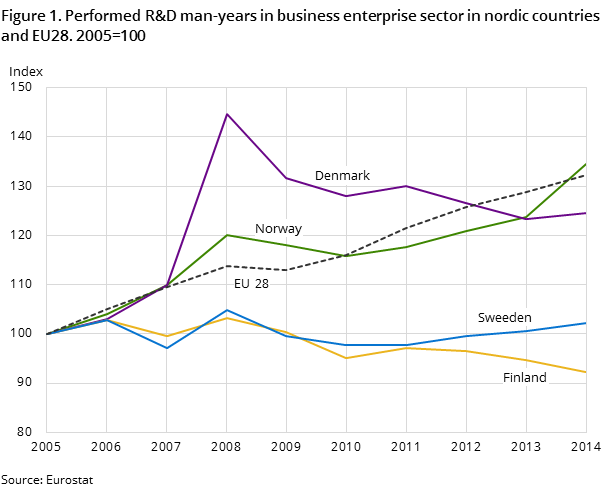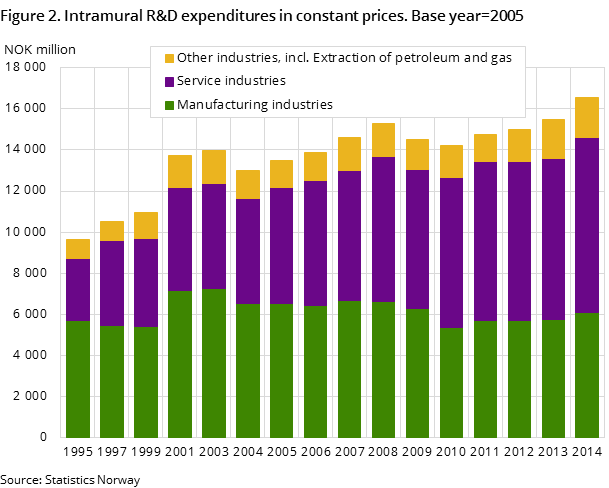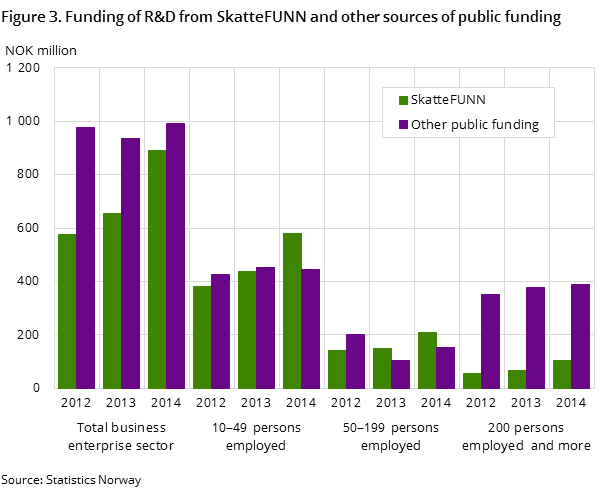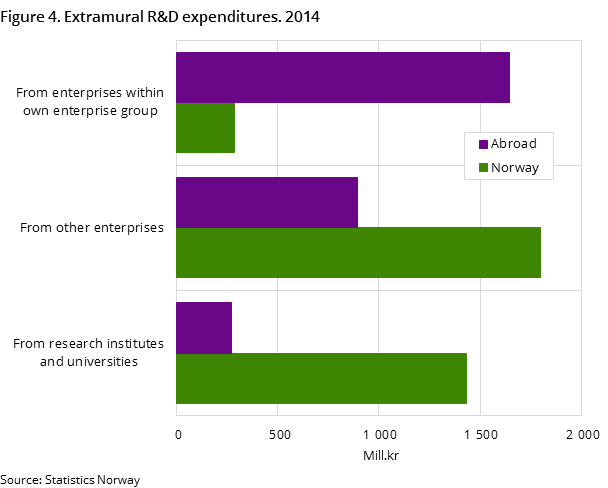Content
Published:
This is an archived release.
Stronger growth in the Norwegian R&D activity than in the EU
The business sector performed research and development (R&D) to a value of NOK 24.8 billion in 2014; an increase of 10 per cent from 2013. At constant prices, the increase was 6.7 per cent. This growth is higher than in the EU and the other Nordic countries.
| 2014 | 2013 - 2014 | ||
|---|---|---|---|
| Level | Percentages | Change in per cent | |
| Intramural R&D expenditure (NOK million) | 24 801.9 | 100 | 10.0 |
| Industry | |||
| Manufacturing | 9 163.0 | 37 | 10.1 |
| Services total | 12 733.7 | 51 | 11.2 |
| Extraction of crude petroleum and natural gas | 1 927.4 | 8 | -4.9 |
| Other industries | 977.8 | 4 | 29.0 |
| Size of enterprise | |||
| 10-49 persons employed | 5 986.2 | 24 | |
| 50-99 persons employed | 2 541.4 | 10 | |
| 100-199 persons employed | 2 942.9 | 12 | |
| 200-499 persons employed | 2 849.7 | 11 | |
| 500 persons employed and more | 10 481.7 | 42 | |
| R&D man-years (number of) | 17 932 | 9.5 | |
| Extramural R&D expenditure (NOK million) | 6 327.9 | 3.2 | |




The final figures for R&D expenditure differ only slightly from the preliminary figures published on 16 October 2015. The R&D expenditures, R&D man-years and purchase of R&D services are adjusted by less than 1 per cent for the total business sector.
Strongest growth in the Nordic countries
The growth in business R&D activity in Norway is strong in an international context. Performed R&D man-years in Norway, including industry-oriented research institutes, were 8.7 per cent higher in 2014 than in 2013. The corresponding figure for the EU was 2.6 per cent. The growth was also lower in the other Nordic countries. Both Sweden and Denmark had a weak growth, around 1.5 per cent, while the negative trend continued for Finnish business enterprises with a decline of 2.5 per cent from 2013. Taking the period 2005-2014 as a whole, the growth in Norway and the EU has been approximately equal, and clearly higher than the other Nordic countries.
Growth in R&D expenditure shows the same pattern as measured in national currency, but measured in euro the development for Norway is weaker due to the low exchange rate of the Norwegian krone. If we look at R&D expenditure as a share of the GDP, the share for Norway is lower than for both the EU and the other Nordic countries. The Norwegian business sector's share is 0.9 per cent, while the share for EU28 is 1.3 per cent, and Finland, Sweden and Denmark are around 2 per cent. However, the trend for Norway is upwards, while the other Nordic countries have the opposite trend. Traditionally, Norwegian industry has a relatively low share of total R&D in comparison to the other Nordic countries.
Highest real growth since 2001
Measured in constant prices, the R&D expenditures in the business enterprise sector were 6.7 per cent higher in 2014 than in 2013. This is the highest real growth recorded since 2001. There has been a sustained real growth of 16 per cent in the industry’s R&D expenditures since 2010. The financial crisis resulted in a fall in the R&D activity in 2009 and 2010, but also in the years before the financial crisis there was a real growth for several years.
The R&D activity, however, has evolved differently in the various industries. Within extraction of crude petroleum and natural gas and support activities the level has been fairly stable over a long period, but with a peak in 2013. Looking at the main industries of manufacturing and services, the development is very different. The service industries as a whole have had more or less a steady real growth in the period from 1995, with only a slight decline in 2009. Just before the financial crisis (2008), the R&D activity in the service sector exceeded the level in the manufacturing industry and has since increased its leading position. It is largely ICT services and engineering activities that have contributed to the strong performance during the period.
The R&D activity in manufacturing has been more varied and the development has also been different across the various manufacturing industries. Manufacturing as a whole experienced some real growth in its R&D expenditure up to 2007. The financial crisis had a greater impact on manufacturing than services, but the trend has stabilised in recent years. Part of the shift between manufacturing and services is due to the reclassification of units from manufacturing to services, but it is difficult to quantify this.
Strong increase in SkatteFUNN funding
Enterprises largely finance their R&D activities with their own funds, with more than 75 per cent of funding being sourced internally. When funding from other enterprises in the same group is included, the figure is almost 90 per cent. Public funding, including SkatteFUNN, amounts to nearly 8 per cent.
There was a strong growth in the use of the tax credit system SkatteFUNN in 2014. Total tax credits for R&D are more than 30 per cent higher in 2014 than in 2013. The increase is largely caused by the higher amount for R&D expenditure eligible for tax credit; from a total of NOK 11 million in R&D expenditure in 2013 to NOK 22 million in 2014. The figures from the R&D survey show that funding via SkatteFUNN was almost as extensive as other public funding in 2014; SkatteFUNN accounted for 90 per cent of other public funding of R&D for the business enterprise sector as a whole. For enterprises with up to 200 employees, SkatteFUNN is clearly a more important source of funding than other public support, while for the largest enterprises other public support means more.
Large part of R&D services acquired from abroad
In addition to performing their own research and development, many enterprises acquired R&D services from other actors. The total expenditures for purchased R&D amounted to NOK 6.3 billion in 2014. Purchase of R&D services from other Norwegian enterprises accounted for 28 per cent of this. Research institutes, universities and colleges accounted for 23 per cent. Purchase from foreign actors accounted for 44 per cent. Over half of these are deliveries from foreign enterprises in the same enterprise group.
In recent years, crude petroleum and natural gas and service industries in particular have had high expenditures in the purchase of R&D services. Extraction of crude petroleum and natural gas services purchased services worth NOK 2.1 billion in 2014, but experienced a slight decrease compared to 2013. The manufacturing industry increased its expenditures of R&D services by almost NOK 260 million, to a total of NOK 1.7 billion. In comparison, service industries purchased R&D services worth NOK 2.2 billion
Norway's total R&D efforts
The total R&D expenditures for Norway were NOK 53.9 billion in 2014. In addition to the business enterprise sector, R&D activity worth NOK 16.7 million was carried out in the higher education sector and NOK 12.3 million in the research institute sector. More information about total R&D activity is available at NIFU.
Uncertainty of the resultsOpen and readClose
R&D statistics are based on information collected from the enterprises. All enterprises with 50 employees or more are included. In addition, a sample of enterprises with 10-49 employees is drawn and total figures for this group are calculated based on this sample. As a result, there is greater uncertainty surrounding the results for the small enterprises.
SkatteFUNN figures in R&D survey differ from figures from the tax authoritiesOpen and readClose
The SkatteFUNN figures from the R&D survey differ in absolute terms from figures from the tax authorities. The main reason is that the R&D survey in 2014 only covers enterprises with at least 10 employees and just a sample of enterprises with 10-49 employees. Neither does the R&D survey cover all industries. For SkatteFUNN enterprises that participate in the R&D survey, the amount may well have been recorded in different years and different amounts may have been reported to the R&D statistics for various reasons.
New tables in StatBankOpen and readClose
New tables have been added to StatBank, including thematic and technology fields and a table with county figures. More tables will be available during February.
Find more figures
Find detailed figures for Research and development in the business enterprise sector
Contact
-
Kristine Langhoff
E-mail: kristine.langhoff@ssb.no
tel.: (+47) 40 90 24 39
-
Claudia Berrios
E-mail: claudia.berrios@ssb.no
tel.: (+47) 40 90 24 51
-
Harald Fondevik
E-mail: harald.fondevik@ssb.no
tel.: (+47) 40 90 24 47
